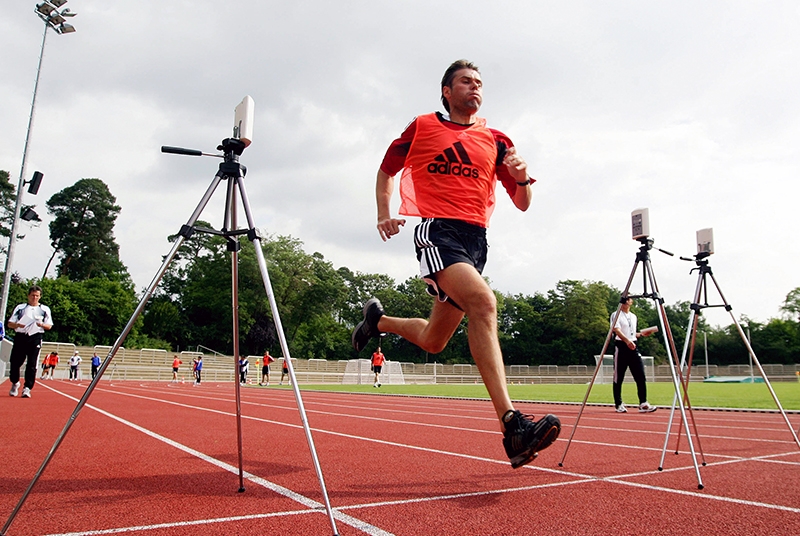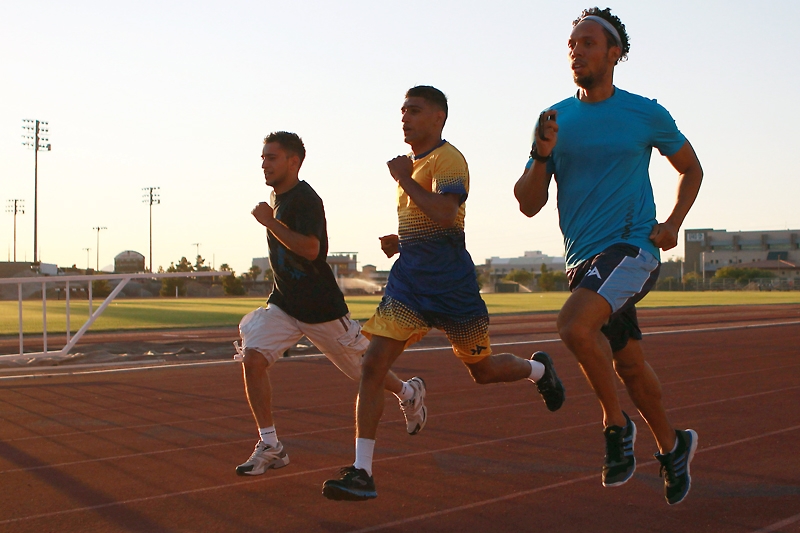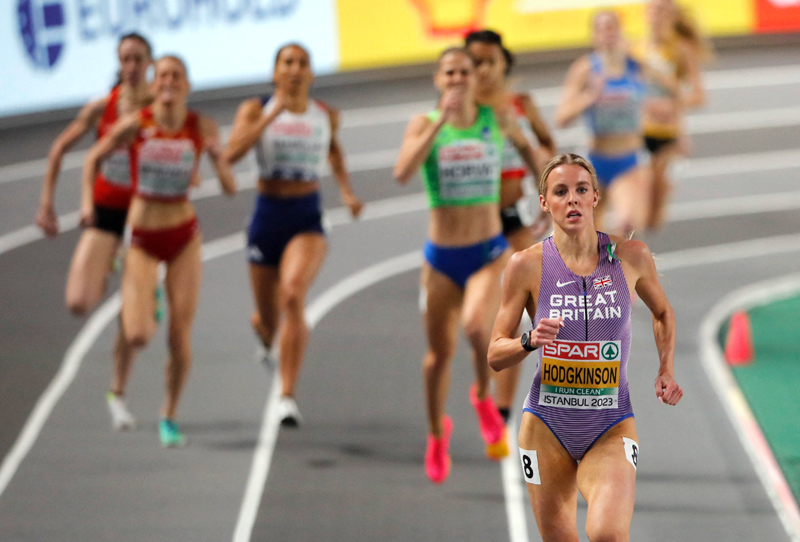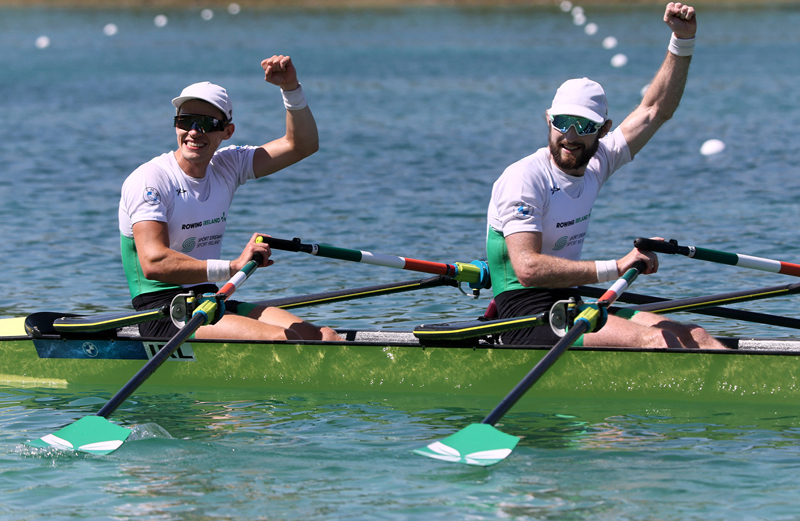You are viewing 1 of your 1 free articles. For unlimited access take a risk-free trial
Interval training: rest assured of excellence!

What’s the optimum rest interval type and length in between interval efforts? SPB looks at what the research says about this often neglected aspect of interval training
When constructing an interval program, it’s natural to focus on how long and how hard each work interval is, and how many interval repeats are performed. That’s not surprising because it’s the short bursts of relatively intense work that are responsible for the fitness and performance benefits interval training brings. What’s often overlooked, however, is the rest interval, which is an integral part of the interval training process.There are two key questions pertaining to rest that need to be considered when designing an interval program:
- How long should athletes rest in between each interval effort?
- What kind of rest should they take? Should it be passive rest (where athletes simply stop and rest completely) or should it be active rest (where athletes slow to a very comfortable pace but still keep moving)?
Active or passive rest?
On the face of it, the term ‘active rest’ might seem like a contradiction in terms. In physiological terms however, the body can ‘rest’ and recover even during periods of light activity. Indeed, there are sound theoretical reasons why active rest between each work interval could be more advantageous than complete or passive rest.One of these is that lying, sitting or even standing around motionless between each work interval will do little to promote enhanced blood flow to recovering muscles. This is in contrast to gentle activity, which produces sustained rhythmic movement in the muscles, stimulating blood flow and so helping to transport nutrients to and metabolic by-products away from recovering muscles. There’s another benefit of being more active during recovery; the rhythmic contraction of muscles helps to promote lymph drainage, which carries away waste products via the lymph system.
Active benefits
Some of these theoretical benefits have been borne out in scientific studies. For example, research on runners has shown that active recovery immediately after hard intervals encourages recovery and reduces muscle lactate levels faster than complete rest (passive recovery). In one study on two groups of runners performing intense interval training consisting of 6-second bursts with 5-minute rest periods, one group rested completely while a second group exercised at 30% intensity between their intervals (active rest). The active group reduced blood lactate levels faster and achieved a higher average power output throughout their workout(1).There’s good evidence that this faster rate of lactate removal is because of the increased flow of blood and oxygen in muscles during active recovery. An elegant experiment using Nuclear Magnetic Resonance Spectroscopy (NMRS) looked at the phosphate ions (from ATP) in the muscle fibers of male long distance runners(2). It showed that during active recovery after hard exercise, the acidity of the environment of the phosphate ions (related to an accumulation of lactic acid) dropped six times more quickly compared to passive recovery! The only explanation for this was the increased oxygen supply and efficient removal of lactate-induced acidity as a result of the greater blood flow.
There’s also good evidence that active recovery helps combat lactate accumulation from studies on swimmers. One study looked at swimmers who performed 10 x 200m flat-out intervals, each separated by 10 minutes of either active or passive rest(3). In addition, some swimmers recovered passively but with massage also given. The results were pretty unequivocal; the blood levels of lactate at the end of each rest period were lowest after active rest (5.72mmol per litre) and highest when passive rest was taken (10.94mmol per litre). And while the massage helped, it only lowered blood lactate to 7.10mmol per litre (see figure 1). Moreover, the swimmers who rested actively performed significantly better in the subsequent 200m bouts than those who rested passively.
Figure 1: The effects on blood lactate of active rest, passive rest and massage in swimmers(3)

Blood concentration of lactate after 10 minutes of differing rest type: 1= active rest; 2 = passive plus massage; 3 = pure passive rest.
Another study looked at the effects of active vs. passive rest periods within an interval training program carried out by 24 male subjects(4). The subjects were split into three groups: a control group who did no interval training, an active recovery group who rested actively between intervals and a passive group who rested passively between intervals. Before and after the 3-week training program, the researchers measured the maximal oxygen capacities of the subjects as well as their levels of stress hormones. The results showed that it was the active group who responded (ie made gains) in the maximal oxygen uptake test following the three weeks of training. However, the downside was that the active recovery seemed to induce more metabolic stress in the subjects – ie it increased the overall training load.
Caveats
Although a number of other studies have shown that active rest is more effective at helping to clear lactate and other by products of exercise from muscles than passive rest, not all studies have concluded that active rest yields superior results to passive rest. For example, a German study examined the effects of a 2-week high-intensity interval programme on maximal oxygen consumption and parameters of exercise performance in 16 junior triathletes(5). In particular, the researchers wanted to see how the results of this programme were influenced by the type of rest the triathletes took in between their work intervals.The triathletes performed a total of 15 high-intensity interval sessions within three separate 3-day training blocks. Before and one week after the last training session, the athletes performed a graded exercise test to determine their maximum oxygen uptake capacities and a time trial during which power outputs were measured. The results showed that in terms of peak power output during the graded exercise test and time trial performance, all the triathletes made gains, regardless of the type of rest they took during intervals. However, it was the passive group triathletes who showed better endurance gains overall as they were able to sustain higher continual power outputs near their maximum oxygen uptake level.
These results might seem surprising, especially given that the total workload of the passive rest group was less than the active rest group. However, one possible explanation is that this 15-day period of interval training was very intense compared to the triathletes’ normal schedules. The extra work involved in the active rest intervals therefore may have pushed them that bit further into a slightly overtrained state, which resulted in less fitness gains than they might otherwise have achieved.

Another study on rest type during intervals looked at team sports involving repeated short-duration sprints(6). Nine moderately-trained men, most of whom regularly competed in various team sports, performed four repeated-sprint tests on cycle ergometers (six 4-second sprints every 25 seconds), at weekly intervals. In two of the trials, the sprints were separated by 21 seconds of active recovery, which involved cycling at around 32% of VO2max. In the other two trials, the sprints were separated by passive recovery periods, in which the athletes did nothing. The researchers compared the athletes’ performances in the two sets of trials and also analysed samples of thigh muscle tissue before and after each of the four tests to check levels of phosphocreatine, creatine and lactate.
As expected, peak power outputs produced during sprints 2-6 were significantly lower than for the first sprint, regardless of what type of recovery was used. However, there was a significantly lower peak power output and a greater drop in power decrement for the sixth sprint with active recovery than with passive recovery. Moreover, muscle lactate levels were significantly higher and phosphocreatine somewhat lower after the tests involving active rest recovery showing poorer recovery between sprints.
Of course, it makes no sense in terms of sport and competition to suggest that team players should stand still between repeated-sprint bouts so the researchers still concluded that training for repeated-sprint performance should involve active rather than passive recovery periods. However, what this study did show is that active rest can have some negative impact on subsequent very intense intervals.
How long should my rest periods be?
The fact that a period of active rest might negatively affect your ability to perform a subsequent flat-out sprint interval is perhaps not surprising. However, some research indicates that what really counts is the length of the rest period rather than whether it’s active or passive. In a 2011 study, British researchers looked at the effects of a constant sprint-to-rest ratio and different recovery modes on repeated sprint performance(7). Three repeated sprint protocols were used (22 × 15, 13 × 30, and 8 × 50 m), with each having an active and passive recovery. Three repeated sprint protocols were used (22 × 15m, 13 × 30m, and 8 × 50 m), each using both an active and passive recoveries between sprints and each protocol was conducted with an initial sprint-to-rest ratio of 1:10 (ie however long the sprint distance took, the rest between sprints was 10 x as long).What became apparent was that in the 22 repeats of 15-metre sprints, sprint performance was didn’t change as the set progressed, regardless of which type of rest was used. In the 13 repeats of 30 metres, the last sprint was an average of 0.2 seconds slower than the first but again, this result was the same regardless of whether active of passive rest was taken. In the 8 x 50m sprints, the final sprint was on average 0.39 seconds slower than the first, but yet again, the type of rest taken was irrelevant. The key take-home point here is that if the rest interval is sufficiently long, it doesn’t seem to matter whether recovery is active or passive.
How should active recovery be performed?
Interval training is likely to be effective regardless of whether your rest intervals are active or passive. However, it’s fair to say that on balance, there’s more slightly evidence in favour of active recovery during intervals, which begs the question of how best to perform active recovery. Unfortunately, there are no hard and fast prescriptions, particularly as what’s most appropriate will depend on the circumstances and your individual preferences. However, we can turn to research from swimming (a sport where much of the day-to-day training is based on interval work) for some useful pointers.A group of studies conducted over a number of years by Greek researchers Department of Physical Education and Sport Science, Democritus University of Thrace makes for enlightening reading. In the first study, the scientists investigated the effect of different intensities of active recovery on performance during repeated sprint swimming(8). Nine male well-trained swimmers performed eight repetitions of 25m sprints (8 x 25m) interspersed with 45-second intervals, followed by a 50m sprint test 6 minutes later. During the 45-seconds and 6-minute interval periods, the swimmers either rested passively or swam at an intensity corresponding to 50% and 60% of their individual 100m speed.
The first 25m sprint was not different across the trials, but performance decreased after sprint #2 during both the active recovery trials compared with the passive recovery trial (see figure 2). Performance time for the 50m sprint performed 6 minutes after the 8 x 25 m sprints however was no different between trials. These results indicate that 45 seconds of active recovery at intensities corresponding to 50% and 60% of the 100m velocity during repeated swimming sprints decreased performance even though blood lactate levels were lower. However, when a 6-minute recovery was given at the end of the sprints, active rest did not affect performance on a subsequent 50m sprint. The researchers concluded that ‘passive recovery is advised during short-interval repeated sprint training’ in well-trained swimmers. However, this study also showed that when the period of active rest was much longer, it was possible to recover fully for a (longer) 50m sprint.
Figure 2: Effects of active/passive rest on subsequent 25m swim sprint times (sprint #2 onwards)(8)

In the first 25m sprint, the recorded times were similar. But from sprint #2 onwards, the swimmers who performed active rest at either 50% or 60% of their 100m swim speed swum their subsequent 25m intervals significantly slower.
In a follow-up study published in 2008, the same group examined the effects of active and passive rest periods of various durations after a 100m swimming test performed at maximal effort(9). The active rest comprised of swimming at 60% of the swimmers’ normal 100m speed. Eleven competitive swimmers completed two 100m tests at maximum swimming effort with a 15-minute interval under three experimental conditions:
- 15 minutes of passive rest
- 5 minutes of active rest/10 minutes of passive rest
- 10 minutes of active rest/5 minutes of passive rest
A third study followed a similar design to the 2006 study but this time looked at active recoveries performed at 40% and 60% of the swimmers’ 100m speeds(10). Ten male competitive swimmers performed 8 × 25m sprints with 120-second rest intervals followed by a 50m sprint 6 minutes later. During the 120-second and the 6-minute interval periods swimmers rested passively or swam at an intensity that corresponded to 40% and 60% of the oxygen usage of their individual 100-m velocities.
This time, two minutes of active rest at 40% of the swimmers’ 100m oxygen consumption values was equally as effective as two minutes of passive rest in allowing the swimmers to fully recover between the 25m sprints. The 60% active recovery protocol did not allow full recovery in between the sprints but did allow recovery for the 50m sprint six minutes later.
Summing up, what this study showed is that even when the rest duration was extended to two minutes (compared to 45 seconds in the 2006 study), 60% active recovery was still too vigorous to allow full recovery for repeated sprint performance. However, 40% active recovery was effective, indicating that both rest times and the intensity of active rest will determine recovery effectiveness during intervals.
Summary
There’s a lot to take in here, so let’s try and summarise in order to give practical guidelines. Firstly, there’s no doubt that active rest does help reduce the accumulation of blood lactate during a set of intervals. There’s also no doubt that by resting actively, you’ll achieve a higher overall work rate during your intervals than if you just rest passively. There’s even some evidence showing that the overall effectiveness of intervals in enhancing aerobic performance could be greater when active rest periods are used, albeit at a cost of higher metabolic stress.However, there are a number of ifs, buts and maybes to consider too. The research on junior triathletes who performed a very intense period of interval training showed reduced gains in endurance performance. This suggests that active rest periods might not be best when training loads are very high because the extra workload they add to the total load could result in excessive metabolic stress. Also, active recovery during sprint intervals could be counterproductive if the rest periods are very short (as demonstrated in the team sport study). By contrast, when the rest periods are relatively long (as in the study on sprinters), active rest is just as effective as passive rest for recovery.
This principle also ties in well with the studies on swimming, which showed that passive recovery is preferred during short-interval repeated sprint training’ but that when the period of active rest was much longer, it was possible to recover fully for a subsequent effort. Indeed, when the rest period becomes long and the work intervals themselves are longer, it seems that some active recovery (to reduce lactate) is beneficial to the performance of those intervals. The key though seems to be to keep the intensity of active recovery very gentle.
In short, during very intense (sprint-like) intervals, rest periods need to be extended relative to the work interval and any active rest should be extremely gentle – indeed, passive may be better. For hard but not flat-out intervals, active recovery is likely to produce greater benefits!
References
- Med Sci Sports Exerc. 1996 Apr;28(4):450-6
- NMR Biomed. 1996 Feb;9(1):13-9
- J Sports Med Phys Fitness. 2012 Apr;52(2):122-7
- Int J Sports Med. 2013 Feb 26. [Epub ahead of print]
- J Strength Cond Res. 2013 May;27(5):1384-93
- Med Sci Sports Exerc, vol 38, no 8, pp1492-1499, 2006
- J Strength Cond Res. 2011 Jun;25(6):1695-702
- Appl Physiol Nutr Metab. 2006 Dec;31(6):709-16
- Int J Sports Physiol Perform. 2008 Sep;3(3):375-86.
- J Strength Cond Res. 2011 Jan;25(1):109-16. doi: 10.1519/JSC.0b013e3181b22a9a.
Newsletter Sign Up
Testimonials
Dr. Alexandra Fandetti-Robin, Back & Body Chiropractic
Elspeth Cowell MSCh DpodM SRCh HCPC reg
William Hunter, Nuffield Health
Newsletter Sign Up
Coaches Testimonials
Dr. Alexandra Fandetti-Robin, Back & Body Chiropractic
Elspeth Cowell MSCh DpodM SRCh HCPC reg
William Hunter, Nuffield Health
Keep up with latest sports science research and apply it to maximize performance
Today you have the chance to join a group of athletes, and sports coaches/trainers who all have something special in common...
They use the latest research to improve performance for themselves and their clients - both athletes and sports teams - with help from global specialists in the fields of sports science, sports medicine and sports psychology.
They do this by reading Sports Performance Bulletin, an easy-to-digest but serious-minded journal dedicated to high performance sports. SPB offers a wealth of information and insight into the latest research, in an easily-accessible and understood format, along with a wealth of practical recommendations.
*includes 3 coaching manuals
Get Inspired
All the latest techniques and approaches
Sports Performance Bulletin helps dedicated endurance athletes improve their performance. Sense-checking the latest sports science research, and sourcing evidence and case studies to support findings, Sports Performance Bulletin turns proven insights into easily digestible practical advice. Supporting athletes, coaches and professionals who wish to ensure their guidance and programmes are kept right up to date and based on credible science.












